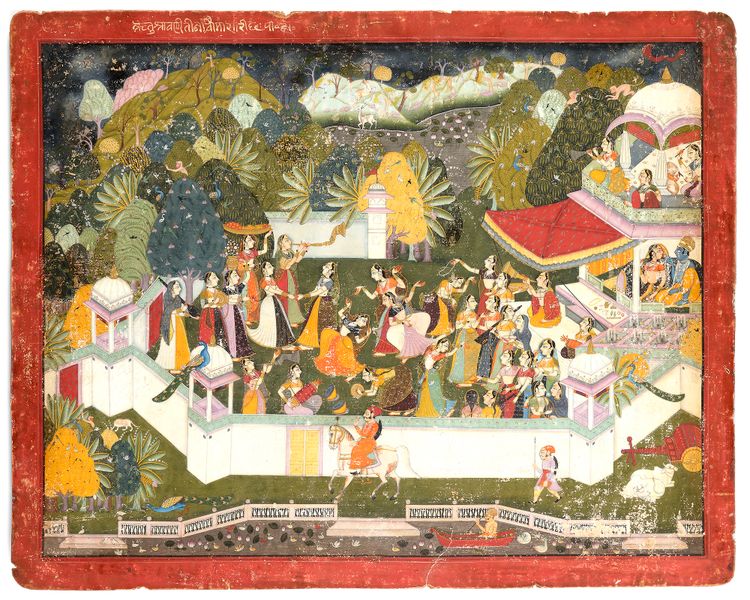BARAHMASA (TWELVE MONTHS) ILLUSTRATION DEPICTING THE CHARACTER AND SYMBOLISM OF THE LATE SUMMER RAINY (SRAVANA & BHADON) BUNDI, RAJASTHAN, CIRCA 1780
Opaque water color on paper.
50.5 by 39 cm.
PROVENANCE
Private collection, Germany.
CATALOGUE NOTE
Lotus-filled lakes and streams coursing with rainwater were
ubiquitous aesthetic spaces in the pictorial and poetic imagi-
nares of early modern northern India. An eighteenth-
century painting, likely made in the town Bundi,near kotah.reveals the elements and emotions associated
with the monsoon Along with the standard tropes of besotted lovers, lightning streaks, thundering clouds, crying
peacocks, monkeys, and dears, the painter
invites us to savor the lotus-filled lakes created by the
onslaught of rain. Blue-hued Krishna and his lover sit together
in a courtly pavilion while a group of ladies celebrates the rainy
season with dance and song or enjoys its cool breezes, playing
on the swings in the verdant landscape. Because ascetic wan-
dering and travel were forbidden during these rainy months,
on the outside of the wall a nobleman astride a white
horse. The artist's goal was to convey the emotional, social,
atmospheric, and sensorial experience of the monsoon season.
On the painting's border, a scribe notes(Retu Sawani Teez Chaumasa ro Tuohaar).Meaning four months of the rainy season. That the picture
depicts the months of Savan (July and August) and Bhadon
August and September), covering the anticipated weather
cycle of the rains, starting from late summer leading up to the
Wetter days. The inscription identifies the painting's presenta-
tion of the bhava of the rainy months.
Poetic verses associated with the rainy months of Savan
and Bhadon were not always inscribed on monsoon paintings.
However, the citation of familiar images and tropes across
innumerable paintings persuades us that historical viewers,
like contemporary art historians, plausibly related these
painterly visions to the literary descriptions that circulated
within courtly contexts and beyond. The poetic genre of the
barah-masa was the paramount expression of the moods of
people, places, flora, and fauna in the rainy season. The barah-
masa is always structured as a lament divided into descrip-
tions of the twelve months, each expressing the pain of
separation when the lover of a nayika, the female heroine or
lover in the Sanskrit and Hindi courtly literary tradition, goes
abroad.' The poet Keshavdas, one of northern India's most
prominent exponents on aesthetic theory in Brajbhasha, com-
posed an extensive barah-masa in his acclaimed Kavipriya
(1601).° His verses describing the rainy months of Savan and
Bhadon are in the voice of a woman desperately trying to convince her lover to stay.
A painting from the series is in the Virginia Museum of fine arts, Richmond

